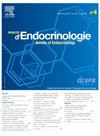Gonadotropic axis following endoscopic surgery for pituitary neuroendocrine tumor in patients of reproductive age
IF 2.9
3区 医学
Q3 ENDOCRINOLOGY & METABOLISM
引用次数: 0
Abstract
Purpose
Pituitary neuroendocrine tumor (PitNET), excluding prolactinoma, often requires endoscopic endonasal surgery (EES). Identifying predictive factors for complications, and particularly rare ones such as hypogonadotropic hypogonadism (HH) that may affect fertility, is challenging. This study investigated de-novo postoperative HH and its potential impact on fertility.
Methods
We conducted a retrospective study of 211 patients undergoing EES. HH was evaluated using age- and gender-specific criteria. The characteristics of patients of reproductive age were analyzed to identify risk factors for de-novo postoperative HH.
Results
Twelve of the 60 patients of reproductive age with no preoperative HH (20%) developed de-novo HH within 4–6 months’ follow-up, with 7 (12%) presenting long-term HH (median: 893 days). De-novo HH was significantly associated with corticotroph adenoma (P = 0.01). Median tumor size was greater in HH than non-HH patients (P < 0.01).
Conclusion
De-novo HH is a frequent complication of pituitary surgery, affecting 1 in 5 patients in our cohort, and is persistent in most cases. While risk factors such as large tumor size and corticotroph subtype were identified, the condition is still difficult to predict. These findings underscore the importance of integrating this risk into preoperative counseling and follow-up.
生殖期患者垂体神经内分泌肿瘤内镜手术后促性腺激素轴。
目的:垂体神经内分泌肿瘤(PitNET),不包括催乳素瘤,通常需要内镜下鼻内手术(EES)。确定并发症的预测因素,特别是罕见的,如可能影响生育的促性腺功能减退(HH),是具有挑战性的。本研究探讨了术后新生HH及其对生育能力的潜在影响。方法:我们对211例接受EES的患者进行回顾性研究。HH采用年龄和性别标准进行评估。分析育龄患者的特点,确定术后再发HH的危险因素。结果:60例术前无HH的育龄患者中,有12例(20%)在随访4-6个月内出现从头发HH, 7例(12%)出现长期HH(中位:893天)。新生HH与皮质性腺瘤有显著相关性(p=0.01)。HH患者的中位肿瘤大小大于非HH患者(p < 0.01)。结论:新生HH是垂体手术的常见并发症,在我们的队列中影响1 / 5的患者,并且在大多数病例中持续存在。虽然确定了大肿瘤大小和促皮质细胞亚型等危险因素,但病情仍然难以预测。这些发现强调了将这种风险纳入术前咨询和随访的重要性。
本文章由计算机程序翻译,如有差异,请以英文原文为准。
求助全文
约1分钟内获得全文
求助全文
来源期刊

Annales d'endocrinologie
医学-内分泌学与代谢
CiteScore
4.40
自引率
6.50%
发文量
311
审稿时长
50 days
期刊介绍:
The Annales d''Endocrinologie, mouthpiece of the French Society of Endocrinology (SFE), publishes reviews, articles and case reports coming from clinical, therapeutic and fundamental research in endocrinology and metabolic diseases. Every year, it carries a position paper by a work-group of French-language endocrinologists, on an endocrine pathology chosen by the Society''s Scientific Committee. The journal is also the organ of the Society''s annual Congress, publishing a summary of the symposia, presentations and posters. "Les Must de l''Endocrinologie" is a special booklet brought out for the Congress, with summary articles that are always very well received. And finally, we publish the high-level instructional courses delivered during the Henri-Pierre Klotz International Endocrinology Days. The Annales is a window on the world, keeping alert clinicians up to date on what is going on in diagnosis and treatment in all the areas of our specialty.
 求助内容:
求助内容: 应助结果提醒方式:
应助结果提醒方式:


